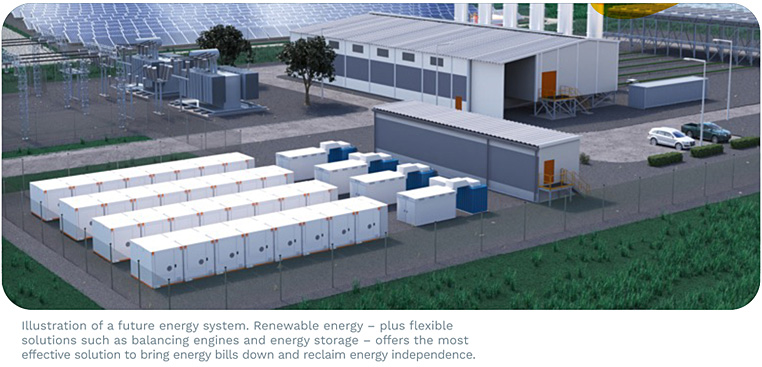 As Europe scrambles to replace Russian hydrocarbons and shore up its energy supply, there is a once-in-a-generation opportunity to lay the foundations for net zero, whilst cutting energy bills and increasing energy independence.
As Europe scrambles to replace Russian hydrocarbons and shore up its energy supply, there is a once-in-a-generation opportunity to lay the foundations for net zero, whilst cutting energy bills and increasing energy independence.
However, with energy prices continuing to rise at an alarming pace, baseload fossil fuel power plants are being refired. In Germany, mothballed coal plants are being restarted, with coal trains now taking priority over passenger transport as the country struggles to deal with the increased demand. In the UK, ambitious plans to achieve a net zero energy system by 2035 have been partially stalled as bills rise and the country transitions to a new prime minister, with some now calling for its 2050 net zero target to be pushed back.
While European states across the continent are looking at fossil fuels as the solution to their current energy security and price challenges, the opportunity to harness the full potential of renewable energy is being missed. Scaling up renewables will cut emissions, reduce energy bills, and improve energy independence across Europe.
A concerted political effort is now required. To achieve its renewable potential, Europe should accelerate its renewable pipeline, diversify its energy supply, and ensure energy is used as efficiently as possible to reduce waste.
The global coal phase-out is at risk of stalling
Last year's Conference of the Parties (COP26) produced a landmark global consensus that coal must be "consigned to history". However, with COP27 around the corner, this previously assured consensus has wavered. The current energy crisis has left many countries planning to extend their reliance on coal.
Nowhere is this truer than in Germany. The new “traffic light” coalition government – formed on a foundation of green policies – has been hit by a perfect storm. Germany was dependent on Russia for around 60% of its gas before the war, meaning it has now been forced to introduce several reactive measures to cut gas consumption by 15% by March 2023, including refiring mothballed coal plants.
Despite this backslide, hopes of a 2030 coal phase-out should not be lost. To get there, new renewable energy is urgently needed. Our modelling indicates that by 2035, Germany will require 780 TWh of renewable energy to operate a net zero electricity system, up from 195 TWh today, supported by grid balancing technology to provide backup supply when energy is not being produced by renewables. That will require at least 45 TWh of new renewable capacity each year, which amounts to a 10% year-on-year increase, or 7500 new wind turbines each year1.
Worryingly, things are moving in the wrong direction. Recently, it was reported that Germany had only built 235 wind turbines this year and permits for new projects were down by 15%.
This trend must be reversed rapidly to ensure that renewable energy can be levelled up to provide almost all of Germany's power demand by the 2030s. The urgent deployment of renewables should be combined with power system flexibility from energy storage and balancing engines which can be converted to run on sustainable fuels in the future.
Germany should rise to this challenge, as the rapid deployment of the renewable energy offers huge opportunities for European nations. Modelling by Wärtsilä demonstrates that if renewables can be scaled up across Europe, gas consumption can be halved, reducing energy costs by €323 billion by 2030. To get there 80 GW of renewable capacity is needed across Europe every year. This would not only usher in an era of energy independence for Europe, but it would also lay the foundations for net zero – and Germany can lead this transition.
Applying policy lessons to the rest of Europe, and the world
We have completed an in-depth study into Germany’s energy system which provides several lessons that can be applied around the world.
Firstly, renewable energy – plus flexible solutions such as balancing engines and energy storage – offers the most effective solution to bring energy bills down and reclaim energy independence. Clear and concerted political will is needed to level-up renewable energy to become the primary source of energy, including the removal of restrictive planning regulations that limit the level of new development.
Secondly, energy efficiency is crucial. Energy waste must not only be reduced by the end user, but also by improved grid flexibility. To provide an example, it cost the UK £500M in 2021 to curtail wind energy due to the presence of inflexible power plants which are unable to manage the intermittency of renewables2. Flexibility solutions, such as balancing engines and energy storage, will help to supercharge the country’s decarbonisation by reducing waste.
Thirdly, energy must come from diverse sources in the future. This is not only true in the short term, but also in terms of building future power systems where energy storage and green hydrogen will play an important role. Ensuring technological diversity is crucial, especially for flexibility where both short and long-duration storage is needed to manage daily and seasonal peaks.
Without doubt, this will require a herculean effort. However, if policymakers around Europe can rapidly scale up renewable energy, and deliver diverse flexible power systems, they will not only significantly reduce carbon emissions but also unlock cheaper energy bills across the continent.

1. An average wind turbine with a capacity of 2.5-3 MW can produce 6000 MWh per year, or 0.006 TWh.
2. https://www.drax.com/press_release/cost-of-turning-off-uk-wind-farms-reached-record-high-in-2021